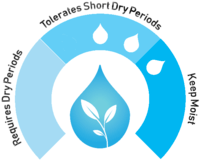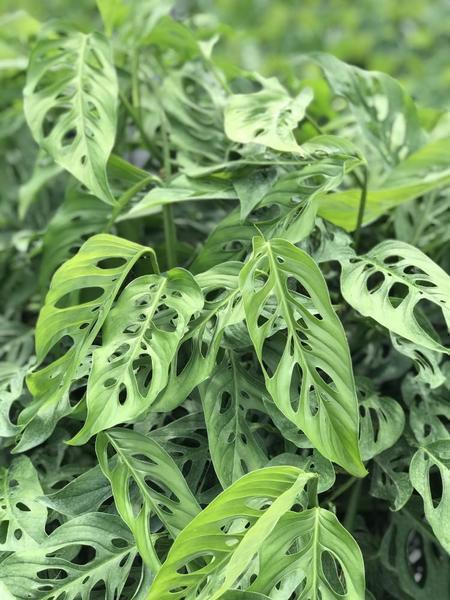
Imagine your favorite hanging basket houseplant. Now imagine the neighbors ten-year-old uses it for target practice to test out a new 500 count box of copper coated bb's. It's a work of art. Sometimes called the Swiss cheese plant the Monstera is a very trendy interior foliage plant. We sell this plant in an 8 inch hanging basket, with runners covering the pot.
The meters below indicate a range of light and tolerance to drought. The ranges are indicated by the little light bulbs and the small water drops.
Light Instructions

Water Instructions


From the Grower:
Mites should be primarily controlled with predator mites. Neoseiulus californicus,(Spical, Spical Plus, Californiline) and Phytoseiulus persimilis,(Spidex, Bio Persimilis, Phytoline) are two excellent choices for spider mite control. If a mite infestation is exceptionally bad, prior to the release of predator mites, spray the plant with water or horticultural oil. Both will provide some knockdown control of spider mites and will not leave a toxic residue that may effect predator mites. If the population of spider mites is red in color, (as opposed to pale yellow with 2 dark black spots) then californicus mites are the only option. Even these predators do not feed heavily on the red spider mite. In this case spraying is the best option. Use a miticide that works well with californicus predator mites (Sultan, Floramite SC, Shuttle O).
Mealybugs can be removed with a systemic insecticide drench and spraying. If pesticides are not an option, try horticultural oil directly sprayed onto the insects. A second and third treatment, if using oils, will be necessary. Space out the sprays at 3 week intervals to break up the mealybug life cycle. Mealybugs will commonly attack older adansonii. The live mealybugs can be found hidden in the small space where the leaf petiole meets the stem of the plant. Turn the whole plant upside down or lift the "runners" up high to properly inspect for mealybugs. Eliminating mealybugs with sprays on the adansonii is difficult. Better success can be had with a systemic drench like Safari or Altus.
Other Links:
Howea forsteriana 'Kentia' Palm
Monstera adansonii
Monstera deliciosa
